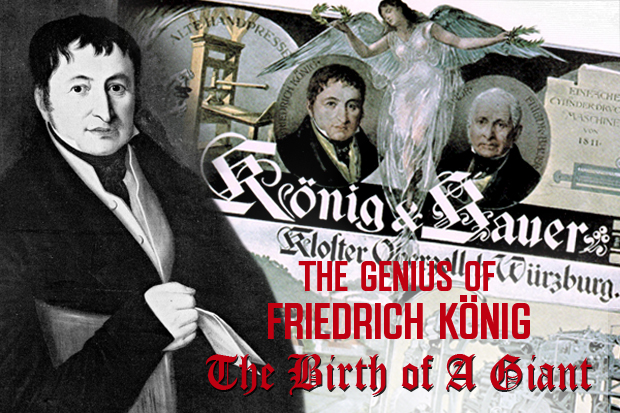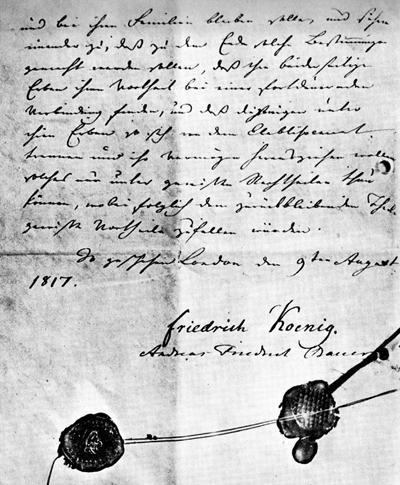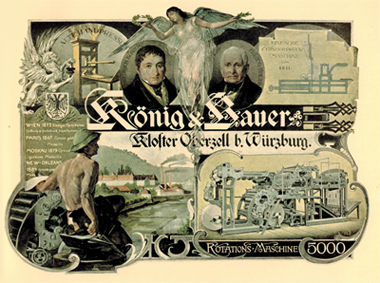
|
|
| Home › Articles › Here |
|

|
||||||||||||||||
| By: Nick Howard | Date: May 2017 | Contact the Author |
Part 1 | Part 2 |
||||||||||||||||
|
Various revisions of the original Times contract culminated with terms that would ultimately seal König’s fate in England and usher forth competition from English engineers. In essence, the revised November 19, 1816, agreement lifted all restrictions upon Walter to use anyone he wished to work on or repair the König presses. The revision restricted the patentees from selling similar machines to any morning papers for less than £1,000 each. These roadblocks would hamper König and he was dejected and heartbroken at what he saw as a betrayal by his now chief partner Bensley (who negotiated the deal) to relegate him to the sidelines. For Bensley, he was not restricted to use the Koenig machines himself. Although Walter’s revised contract stipulated payments (to Walter) if the König press was sold to other papers, Bensley refused to allow König to do so!
Of course, Bensley now had the opportunity to take all the credit as well as profit by selling his direct copy of König’s press. In an article of the Literary Gazette and Journal of the Belles Lettres dated January 3, 1818, the editors wrote: “It may also be interesting to our readers to know, that, commencing with the present number, this Journal will be printed by Messrs. Bensley’s patent machine, an inventive improvement in the art of printing, which reflects honour on the present age, and exhibits a proof of the progress of the art of ingenious mechanism in this country.” Establishing the new factory in southern Germany became an exhausting undertaking for not only was König & Bauer the first Saxon printing machinery manufacturer, but also the very first machine factory in Bavaria. It is said that most raw materials still had to be imported from England and there was virtually no skilled labor. König wrote Walter in December 1818 and complained about the difficulties in finding talent and materials to supply Walter’s spares requirements. He also wrote about his troubles with Bensley: “My way goes up hill, owing principally to Bensley, who has bilked me completely. Yet, I am gaining grounds, and perhaps, I may still have the sad satisfaction of dying rich, after having lived poor.” The problems of re-starting their business in what was then a backward country opened the door for Walter to seek help from others. William Cowper and his brother-in-law, Ambrose Applegath, would benefit the most by König’s genius. The two took out patents citing another Englishman William Nicholson’s never realized patent to skirt König’s own patents, and in the same year brought forth an improved version of König’s press while ushering in a new age of the British steam powered printing press. Nicholson has often been referenced as a “father” of the drum and bed concept. In 1790, he had applied and received a British patent but never acted on or applied it. Nicholson was ignored, and certainly König had never gleaned any concepts he later put in place. British historian, James Moran, described the Nicholson ideas as “insufficient and superficial”.  By 1827, Cowper and Applegath, constructed a new “Multiple Machine with Four Cylinders” which was delivering an astounding 4,000 sheets per hour at The Times of London. The ideas of which they based their press were König’s and not Nicholson’s. This deliberate slight in not citing a previous art (König’s) was a sad testament to König’s brilliance and may have even hastened his death in 1833 at only 59. After all, König was a German. There was little respect by the English for anything and anyone who wasn’t English. Through all of this, König & Bauer never brought suit from the English courts. Had they done so perhaps justice would have prevailed?
König is credited with three milestone technologies: connecting a printing press to a steam engine, using tapes to feed a sheet to the cylinder, and finally using a cylinder instead of a platen. König subsequently modified his press further with an additional cylinder to be the first to “perfect” or print both sides of the sheet in one printing. However, in the monumental first edition of The Times printed on König’s press, there was some solace in the following passage: “So is the best tribute of praise, which we are capable of offering to the inventor of the printing machine, comprised in the preceding description, which we have feebly sketched, of the powers and utility of his invention. It must suffice to say farther, that he is a Saxon by birth; that his name is König; and that the invention has been executed under the direction of his friend and countryman Bauer," Friedrich König and Andreas Bauer would end up winning the war. |
|||||||||||||||||
Contact the Author |
|||||||||||||||||
|
|||||||||||||||






